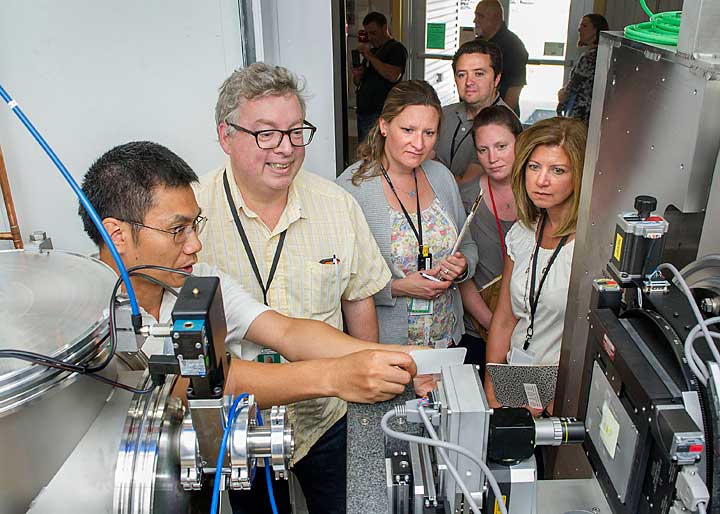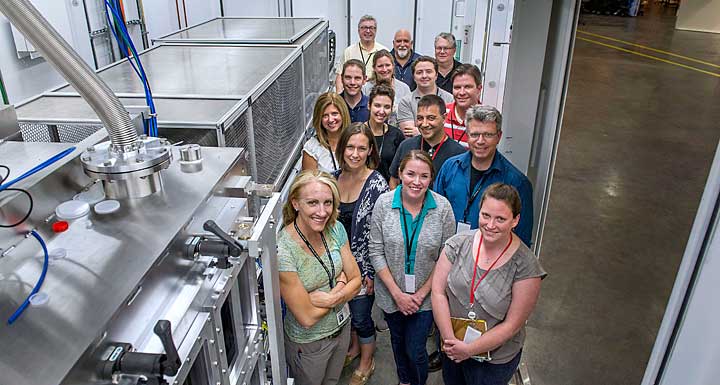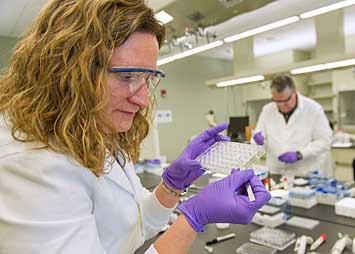Seeing High School Science in a Whole New Light
Training teachers on how to make NSLS-II an accessible tool for students
July 28, 2016
 enlarge
enlarge
Scientist Lin Yang at the LiX beamline demonstrating how the beam hits the sample to high school teachers James Ripka, Mary Kroll, Janet Kaczmarek, Jocelyn Handley-Pendleton, and Fred Feraco.
Coming this fall to a Long Island classroom near you, it’s science at the synchrotron!
The brand-new, multimillion-dollar National Synchrotron Light Source II (NSLS-II), a U.S. Department of Energy (DOE) Office of Science User Facility at DOE’s Brookhaven National Laboratory, is opening its doors to research proposals from high school students. With help from their teachers and Brookhaven’s researchers, the students will come up with their own topics, write proposals requesting time to use NSLS-II’s bright x-ray beams, and observe the results either remotely or in-person. Their proposals will be judged competitively with those from career scientists, helping students learn the ins and outs of writing a successful proposal.
In preparation for the program, Brookhaven’s Office of Educational Programs, with support from the scientific staff at NSLS-II, hosted teacher-training sessions from June 27 to July 1. Educators from all corners of Long Island attended. They received hands-on experience preparing samples, attended science lectures, visited beamlines, and learned about what data can be collected and analyzed.
"It was great working with the local schools," said workshop organizer Aleida Perez of the Office of Educational Programs. "We are excited about engaging both students and teachers in the science that can be done at the NSLS-II, and we look forward to seeing them return as users of our facilities."
Dan Williams, a life sciences instructor at Shelter Island High School, hopes the program will help “get students passionate about real science.” Unlike prepared laboratory units at school, he explained, in real research “we have no idea what’s going to happen, we have no idea what the frontiers are, and half of the fun is getting there.” Williams has experience at Brookhaven from InSynC, a previous incarnation of this program at the original National Synchrotron Light Source.
Jennifer Gatz, a science research and Advanced Placement (AP) biology teacher at Patchogue Medford High School and former exercise physiologist at the Lab’s Occupational Medicine Clinic, concurred with Williams’s sentiment. “This is an inspirational approach. Most of [the students] know their four basic sciences: earth science, biology, chemistry, and physics,” she said. However, she explained, they don’t get to experience the excitement that comes from this level of research. “You have this world-renowned, national light source built nearby, and you have to take advantage of it.”
The hands-on experience will also help break up the monotony of preparing for tests. Gesturing to the teachers who were excitedly collecting and freezing lysosome protein crystals in liquid nitrogen at the workshop, Gatz said, “You can see how excited we all are!”
 enlarge
enlarge
The high school teachers who participated in the workshop are Jennifer Gatz, Karen Kuntz, Jocelyn Handley-Pendleton, Erin Garland, Dan Williams, Janet Kaczmarek, Michael Vaccariello, Kimberly King, John Halloran, Robert Bolen, Fred Feraco, Mary Kroll, James Ripka, Edward Irwin, and Steve Leffler.
The group of teachers will return for a follow-up meeting on August 30th to discuss how to help students create proposals. Some instructors also talked about having students from the different schools meet and collaborate on their projects.
As the training session ended, the teachers left excited for the upcoming year. They’ll go back to their classrooms and present students with a broad spectrum of possibilities for research topics—from demonstrating diffraction patterns on semi-precious gems, to analyzing the still unknown role of lectin protein accumulation in plants.
By engaging students in these real-world research questions, the teachers hope to ignite a passion for science within their students, and potentially inspire them to pursue science-related careers.
As NSLS-II Director John Hill* said when he came by to welcome and rally the teachers, “Everyone we keep in science is a win.”
*Hill is also Deputy Associate Laboratory Director for Energy Sciences at Brookhaven Lab.
Brookhaven National Laboratory is supported by the Office of Science of the U.S. Department of Energy. The Office of Science is the single largest supporter of basic research in the physical sciences in the United States, and is working to address some of the most pressing challenges of our time. For more information, please visit science.energy.gov.
2016-6450 | INT/EXT | Newsroom










